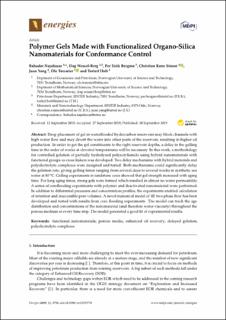| dc.contributor.author | Najafiazar, Bahador | |
| dc.contributor.author | Wessel-Berg, Dag | |
| dc.contributor.author | Bergmo, Per Eirik Strand | |
| dc.contributor.author | Simon, Christian | |
| dc.contributor.author | Yang, Juan | |
| dc.contributor.author | Torsæter, Ole | |
| dc.contributor.author | Holt, Torleif | |
| dc.date.accessioned | 2020-03-18T10:15:09Z | |
| dc.date.available | 2020-03-18T10:15:09Z | |
| dc.date.created | 2019-10-31T10:06:29Z | |
| dc.date.issued | 2019 | |
| dc.identifier.citation | Energies. 2019, 12 (19), 1-28. | nb_NO |
| dc.identifier.issn | 1996-1073 | |
| dc.identifier.uri | http://hdl.handle.net/11250/2647352 | |
| dc.description.abstract | Deep placement of gel in waterflooded hydrocarbon reservoirs may block channels with high water flow and may divert the water into other parts of the reservoir, resulting in higher oil production. In order to get the gel constituents to the right reservoir depths, a delay in the gelling time in the order of weeks at elevated temperatures will be necessary. In this work, a methodology for controlled gelation of partially hydrolyzed polyacrylamide using hybrid nanomaterials with functional groups as cross-linkers was developed. Two delay mechanisms with hybrid materials and polyelectrolyte complexes were designed and tested. Both mechanisms could significantly delay the gelation rate, giving gelling times ranging from several days to several weeks in synthetic sea water at 80 °C. Gelling experiments in sandstone cores showed that gel strength increased with aging time. For long aging times, strong gels were formed which resulted in almost no water permeability. A series of coreflooding experiments with polymer and deactivated nanomaterial were performed. In addition to differential pressures and concentration profiles, the experiments enabled calculation of retention and inaccessible pore volumes. A novel numerical model of 1D two-phase flow has been developed and tested with results from core flooding experiments. The model can track the age distribution and concentrations of the nanomaterial (and therefore water viscosity) throughout the porous medium at every time step. The model generated a good fit of experimental results. | nb_NO |
| dc.language.iso | eng | nb_NO |
| dc.publisher | MDPI | nb_NO |
| dc.rights | Navngivelse 4.0 Internasjonal | * |
| dc.rights.uri | http://creativecommons.org/licenses/by/4.0/deed.no | * |
| dc.subject | Porous media | nb_NO |
| dc.subject | Enhanced oil recovery | nb_NO |
| dc.subject | Delayed gelation | nb_NO |
| dc.subject | Polyelectrolyte complexes | nb_NO |
| dc.subject | Functional nanomaterials | nb_NO |
| dc.title | Polymer Gels Made with Functionalized Organo-Silica Nanomaterials for Conformance Control. | nb_NO |
| dc.type | Journal article | nb_NO |
| dc.type | Peer reviewed | nb_NO |
| dc.description.version | publishedVersion | nb_NO |
| dc.rights.holder | This is an open access article distributed under the Creative Commons Attribution License which permits unrestricted use, distribution, and reproduction in any medium, provided the original work is properly cited | nb_NO |
| dc.source.pagenumber | 1-28 | nb_NO |
| dc.source.volume | 12 | nb_NO |
| dc.source.journal | Energies | nb_NO |
| dc.source.issue | 19 | nb_NO |
| dc.identifier.doi | 10.3390/en12193758 | |
| dc.identifier.cristin | 1742638 | |
| dc.relation.project | Norges forskningsråd: 262644 | nb_NO |
| cristin.unitcode | 7401,80,7,0 | |
| cristin.unitcode | 7401,80,64,0 | |
| cristin.unitname | Petroleum | |
| cristin.unitname | Materialer og nanoteknologi | |
| cristin.ispublished | true | |
| cristin.fulltext | original | |
| cristin.qualitycode | 1 | |

